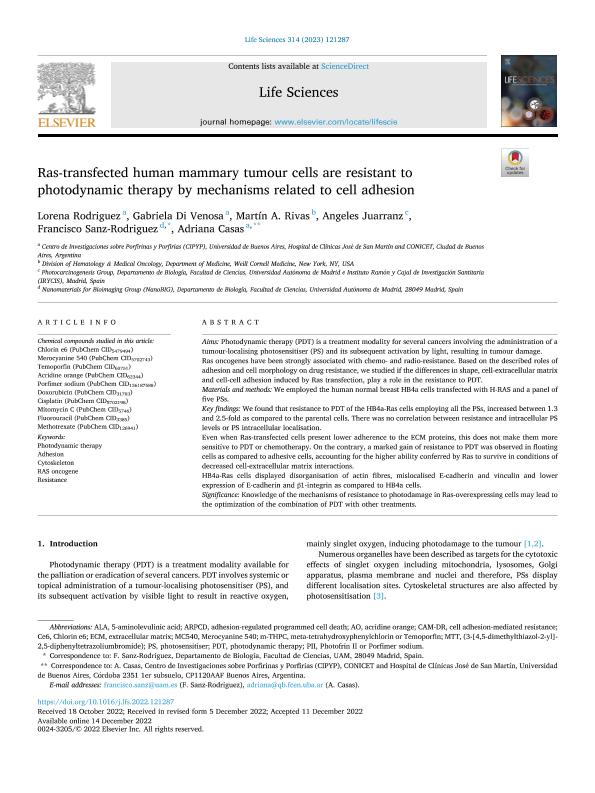Mostrar el registro sencillo del ítem
dc.contributor.author
Rodriguez, Lorena Gabriela

dc.contributor.author
Di Venosa, Gabriela Mariana

dc.contributor.author
Rivas, Martín A.
dc.contributor.author
Juarranz, Angeles
dc.contributor.author
Sanz Rodriguez, Francisco
dc.contributor.author
Casas, Adriana Gabriela

dc.date.available
2024-02-23T12:06:22Z
dc.date.issued
2023-02
dc.identifier.citation
Rodriguez, Lorena Gabriela; Di Venosa, Gabriela Mariana; Rivas, Martín A.; Juarranz, Angeles; Sanz Rodriguez, Francisco; et al.; Ras-transfected human mammary tumour cells are resistant to photodynamic therapy by mechanisms related to cell adhesion; Pergamon-Elsevier Science Ltd; Life Sciences; 314; 121287; 2-2023; 1-10
dc.identifier.issn
0024-3205
dc.identifier.uri
http://hdl.handle.net/11336/228158
dc.description.abstract
Aims: Photodynamic therapy (PDT) is a treatment modality for several cancers involving the administration of a tumour-localising photosensitiser (PS) and its subsequent activation by light, resulting in tumour damage. Ras oncogenes have been strongly associated with chemo- and radio-resistance. Based on the described roles of adhesion and cell morphology on drug resistance, we studied if the differences in shape, cell-extracellular matrix and cell-cell adhesion induced by Ras transfection, play a role in the resistance to PDT. Materials and methods: We employed the human normal breast HB4a cells transfected with H-RAS and a panel of five PSs. Key findings: We found that resistance to PDT of the HB4a-Ras cells employing all the PSs, increased between 1.3 and 2.5-fold as compared to the parental cells. There was no correlation between resistance and intracellular PS levels or PS intracellular localisation. Even when Ras-transfected cells present lower adherence to the ECM proteins, this does not make them more sensitive to PDT or chemotherapy. On the contrary, a marked gain of resistance to PDT was observed in floating cells as compared to adhesive cells, accounting for the higher ability conferred by Ras to survive in conditions of decreased cell-extracellular matrix interactions. HB4a-Ras cells displayed disorganisation of actin fibres, mislocalised E-cadherin and vinculin and lower expression of E-cadherin and β1-integrin as compared to HB4a cells. Significance: Knowledge of the mechanisms of resistance to photodamage in Ras-overexpressing cells may lead to the optimization of the combination of PDT with other treatments.
dc.format
application/pdf
dc.language.iso
eng
dc.publisher
Pergamon-Elsevier Science Ltd

dc.rights
info:eu-repo/semantics/openAccess
dc.rights.uri
https://creativecommons.org/licenses/by-nc-sa/2.5/ar/
dc.subject
ACRIDINE ORANGE (PUBCHEM CID62344)
dc.subject
ADHESION
dc.subject
CHLORIN E6 (PUBCHEM CID5479494)
dc.subject
CISPLATIN (PUBCHEM CID5702198)
dc.subject
CYTOSKELETON
dc.subject
DOXORUBICIN (PUBCHEM CID31703)
dc.subject
FLUOROURACIL (PUBCHEM CID3385)
dc.subject
MEROCYANINE 540 (PUBCHEM CID5702743)
dc.subject
METHOTREXATE (PUBCHEM CID126941)
dc.subject
MITOMYCIN C (PUBCHEM CID5746)
dc.subject
PHOTODYNAMIC THERAPY
dc.subject
PORFIMER SODIUM (PUBCHEM CID136187588)
dc.subject
RAS ONCOGENE
dc.subject
RESISTANCE
dc.subject
TEMOPORFIN (PUBCHEM CID60751)
dc.subject.classification
Bioquímica y Biología Molecular

dc.subject.classification
Ciencias Biológicas

dc.subject.classification
CIENCIAS NATURALES Y EXACTAS

dc.title
Ras-transfected human mammary tumour cells are resistant to photodynamic therapy by mechanisms related to cell adhesion
dc.type
info:eu-repo/semantics/article
dc.type
info:ar-repo/semantics/artículo
dc.type
info:eu-repo/semantics/publishedVersion
dc.date.updated
2024-02-20T12:15:51Z
dc.journal.volume
314
dc.journal.number
121287
dc.journal.pagination
1-10
dc.journal.pais
Estados Unidos

dc.journal.ciudad
Amsterdam
dc.description.fil
Fil: Rodriguez, Lorena Gabriela. Consejo Nacional de Investigaciones Científicas y Técnicas. Oficina de Coordinación Administrativa Houssay. Centro de Investigaciones sobre Porfirinas y Porfirias. Universidad de Buenos Aires. Centro de Investigaciones sobre Porfirinas y Porfirias; Argentina
dc.description.fil
Fil: Di Venosa, Gabriela Mariana. Consejo Nacional de Investigaciones Científicas y Técnicas. Oficina de Coordinación Administrativa Houssay. Centro de Investigaciones sobre Porfirinas y Porfirias. Universidad de Buenos Aires. Centro de Investigaciones sobre Porfirinas y Porfirias; Argentina
dc.description.fil
Fil: Rivas, Martín A.. Weill Cornell Medicine; Estados Unidos
dc.description.fil
Fil: Juarranz, Angeles. Universidad Autónoma de Madrid; España
dc.description.fil
Fil: Sanz Rodriguez, Francisco. Universidad Autónoma de Madrid; España
dc.description.fil
Fil: Casas, Adriana Gabriela. Consejo Nacional de Investigaciones Científicas y Técnicas. Oficina de Coordinación Administrativa Houssay. Centro de Investigaciones sobre Porfirinas y Porfirias. Universidad de Buenos Aires. Centro de Investigaciones sobre Porfirinas y Porfirias; Argentina
dc.journal.title
Life Sciences

dc.relation.alternativeid
info:eu-repo/semantics/altIdentifier/doi/http://dx.doi.org/10.1016/j.lfs.2022.121287
dc.relation.alternativeid
info:eu-repo/semantics/altIdentifier/url/https://www.sciencedirect.com/science/article/pii/S0024320522009870
Archivos asociados
